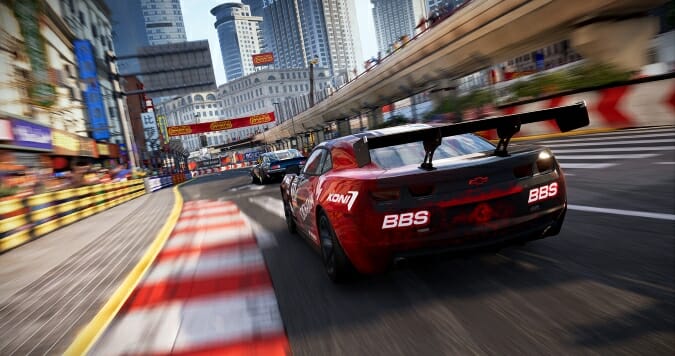
Codemasters’ GRID series has always been in a weird place among racing games, not quite a simulator or an arcade racer but somewhere in the middle, with realistic car handling but a relative lack of car customization options. With the newest title, due out later this year, GRID is getting a soft reboot, and an increased focus on in-race rivalries and dynamic stories.
Simon Barlow, principal game designer on the 2019 edition of GRID, wants players to see the human stories in the races. While simulation games are hyper-focused on accurately depicting car handling and various tweaks to vehicles, and arcade racers tend to focus on the races staying fun without as much care toward realism, GRID is trying to create the dynamic stories that arise within motorsports—rivalries, allies, trading paint and trading positions.
To do this, the latest GRID (which, as you may have noticed, has dropped the numbering seen in previous titles, making talking about it as difficult as any other game that does this) has implemented a race director AI, similar to other dynamic AI systems seen in games like Left 4 Dead. This race director is, put simply, focused on the parts of the race that the player might not be part of. Each of the game’s 400-plus unique AI drivers might be igniting rivalries with one another, running each other off the road, or directing their teammates to protect them as they attempt an overtake.
All of this combines to make a racing game that feels remarkably alive. GRID games have always felt pretty good to drive, but now it feels like they’re more unpredictable. The series’ rewind mechanic makes a return, meaning that if you manage to slam headfirst into a wall (like I did, more than I’d like to remember) hitting a button will rewind the race back to a previous section. Unlike in previous GRID games, however, AI feels more responsive now, more likely to do something different on a rewind. In one situation, I got myself nearly slammed into a pileup coming around a hairpin turn—after a quick rewind, the other racers had, this time, managed to avoid crashing, so my careful approach turned out to be completely unnecessary.
It’s good that the racing itself feels far more developed, because GRID 2019 has a lot of it. The campaign structure from GRID 2 is out, but in its place is a dizzying array of unlockable events—I didn’t count, but it’s easily over a hundred, each with their own car requirements, objectives, and rewards. Player garages and rewards are shared across singleplayer and multiplayer, which means that if you save up to get that sweet drifter or powerhouse track car, you can take it online to qualifying events and show off.
Combined with some fun bonus events (like an all Mini Cooper dash through downtown Havana) and some unique partnerships (like hillclimb events in Japan made in cooperation with the World Time Attack Championships), GRID looks to be taking some bold steps with its simulation-arcade genre. Look out for it on Xbox One and PS4 later this year.
Dante Douglas is a writer, poet and game developer. You can find him on Twitter at @videodante.